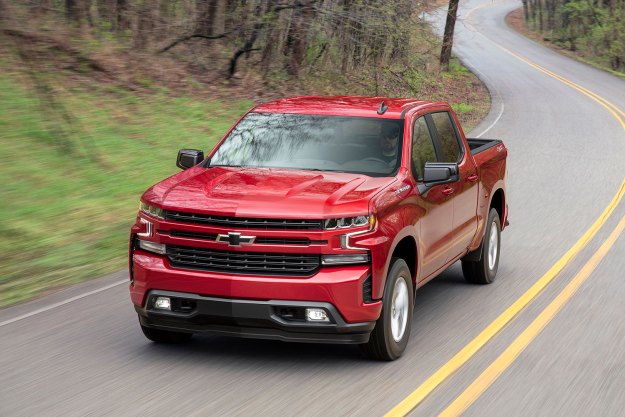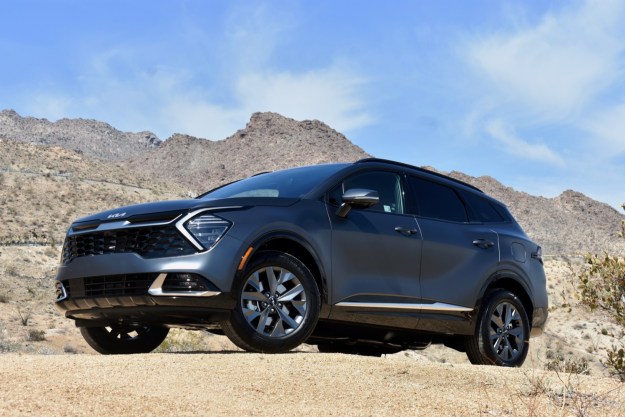
“The new 2.7-liter turbocharged four-cylinder engine may herald a new era for light-duty trucks.”
- Excellent usable power from 2.7-liter turbo
- Dynamic fuel management a winner for V8s
- Tons of new tech in the guts of this truck
- Quiet cabin
- Refined ride and handling
- Interior more or less the same
- 6.2-liter available only on top trims
- 2.7-liter not available on value-oriented trims
Chevrolet unveiled the significantly revised 2019 Silverado (at a distance) at a special event in Dallas last December that was timed to coincide with the 100-year anniversary of the first Chevy trucks ever made. The automaker gave us a closer look at the outside in January at the North American International Auto Show, and this week it let Digital Trends get behind the wheel for the first time at GM’s Milford Proving Grounds near Detroit.
We weren’t in the truck for very long, and we didn’t get to deep dive into the dashboard tech or interior trim options, as this was an engine program only. But we did get enough of the flavor of the gas-powered engine options for 2019 to give a decent accounting of what’s coming down the road. The short version: 2019 will be a very good year for the Chevy Silverado.
That’s good news because the Ford F-150 and Ram 1500 have been bringing the goods in the truck market, and the Big 3 are largely leaving Japanese full-size trucks in the dust. We didn’t get pricing, Environmental Protection Agency information, or towing capacities either this week — so let’s talk engines.
Interior and tech
What we know about the interior is this: It’s bigger than before. Chevy added 1.6 inches to the truck overall, and 3.9 inches to the wheelbase on the crew cab models. The new space was mostly added to the cabs in the back seat (except for the Work Truck trim, which doesn’t have a back seat). The Crew Cab models are much improved in back seat space and comfort, and the extended cab models get more space as well. Chevrolet also announced increased cargo box capacity.

The interiors of the preproduction trucks we drove seemed to be standard Chevy fare. Nothing to complain about, but nothing new and special either. Except for this: Both new trucks we drove (the 5.3-liter V8 and 2.7-liter turbo models) were dramatically quieter in the cabin than the current model. Trim, fit, and finish, as well as the infotainment system, all seemed pretty standard. That may change as Chevy continues to roll out the 2019 Silverado in stages, however, and we were there to experience the engines, not evaluate the speakers.
The tech Chevy revealed this week was all under the hood. The 2.7-liter turbo engine is a DOHC 16-valve direct-injection design developed specifically for the truck market that yields 310 horsepower and 348 pound-feet of torque. To reach those numbers, the new engine uses a dual-volute turbocharger for instant throttle response. While the dual volute unit is similar to a twin-scroll, there are significant design differences, including routing the airflow through the two scroll shapes into opposite sides of the turbine wheel to avoid interference.
We were there to experience the engines, not evaluate the speakers.
The new engine also includes cylinder deactivation on two cylinders, dynamic cam timing, and cam profile changes based on power needs. Both camshafts are two-piece units that offer each valve two or three different lift profiles for high-power, low-power, and deactivation capability. Chevy brought back the old “Tri Power” name for the new system, which should please vintage enthusiasts.
The engine also features an electric water pump to reduce drag on the power system. Overall, the 2019 Silverado with the 2.7-liter represents a 380-pound weight savings over the 2018 model with the V6, and 100 pounds of that is the weight difference between the engines.

On the V8 engines, the big news is the new Dynamic Fuel Management system that takes cylinder deactivation to the next level. Unlike the previous system that changed the engine from a V8 to a V4, the new system offers 17 different deactivation profiles, and can choose among them every 12.5 milliseconds to adapt to changing conditions in real time.
While cylinder deactivation systems have historically worked on whole banks or clusters of cylinders, the new system works across multiple engine revolutions and cycles the deactivation among all eight cylinders. Combined with a new vibration absorption system in the transmission’s torque converter, the system is completely transparent to the driver and passengers. Chevy says that the new 5.3-liter system in the new chassis reduces curb weight up to 450 pounds, depending on the truck configuration.
In addition to the gasoline engine options, an all-new Duramax 3.0-liter inline-six turbo diesel will become available in early 2019.
Driving experience
Drive quality is all-important this year, as Ram really raised the bar with the 2019 Ram 1500 and Ford’s been killing it with the 3.5-liter turbo V6. From what we experienced on the various driving surfaces of Milford, the Silverado will have the chops to compete. Driven back-to-back with current models, the 2019 has lighter steering and the whole truck feels lighter and more eager and responsive, while at the same time providing a much-improved smooth and steady ride.
The “Tri Power” name for the new system should please vintage enthusiasts.
The 5.3-liter V8 provides perceived power consonant with its 355 hp/383 torque rating. The 5.3-liter V8 mated to the new 8-speed automatic is a solid choice for towing, performance, and day-to-day use. When compared to the 2018 model with a 6-speed transmission, Chevy’s engineers claimed a half-second better 0-60 time, which would put it right around the mid-6-second range for a typical truck.
But the special experience is the 2.7-liter turbo. We drove the truck before we knew what was under the hood, and my guess was about a 3.0-liter turbo V6, or “one hell of a four-banger.” We didn’t put a clock on 0-60 or freeway passing acceleration, but the engine was brisk, edgy, and ready to rock and roll at all times. The turbo four was also mated to the same 8-speed automatic and made good use of the gears. By comparison, the 4.3-liter V6 (which goes back to the late 1980s) with the 6-speed felt blunted and stodgy.

We could also really feel the difference in suspension and steering response between the 2018 and 2019 models. Short recommendation: If you’re considering a new truck this year, wait for the 2019s before you make a decision.
The EPA has not yet rendered its judgment on any of these engines for 2019, so keep an eye out, but we expect improved V8 ratings over prior years and good results for the 2.7-liter.
Warranty
Chevrolet trucks come with a 3-year, 36,000-mile bumper-to-bumper warranty, with a 5-year, 50,000-mile powertrain warranty. Chevy engineers emphasized the thousands of hours and millions of miles of testing that have gone into both the four-cylinder and the dynamic fuel management system on the V8s, so there’s every reason to expect consistent reliability.
How DT would configure this vehicle
Without question, we’d choose the 2.7-liter engine, which is available only on the “volume” trim levels. Those are the standard LT, off-road-focused LT Trail Boss, and sporty RST. These count as midgrade trims, so they shouldn’t be too expensive, at least if you stick to LT. If we needed to tow a lot of weight, we’d go with a V8 sized to meet our needs, and if the 5.3-liter had enough pull, the very affordable Custom trim would be appealing for a working truck. If you really need the grunt, the 6.2 with the 10-speed configuration is there for you, albeit only on the top LTZ and High Country trims, so talk to your credit union or look to the Silverado HD.
But for the majority of street-driven trucks, that 2.7-liter engine is going to deliver a satisfying drive experience along with an attractive fuel bill. Technology marches on, and it’s rarely taken so big a step as from the old V6 to the new turbo four-cylinder engine. Chevy’s people said they expect about 10 percent of trucks to be equipped with the turbo, but we wouldn’t be surprised if it was much higher. The 2.7-liter engine is being manufactured now in Chevy’s Spring Hill, Tennessee, plant.
Conclusion
Competition in the truck market is brutal because customers want it all: Power, affordability, handling, and interior refinements. From what we saw at the top-secret proving grounds this week, Chevy’s going to bring the goods to compete head-to-head with Ford’s 2.7-liter EcoBoost and Ram’s 5.7-liter HEMI, with or without its mild hybrid helper system. With improved driving dynamics and advanced engine tech, 2019 is going to be a great year for trucks generally, and for the new Chevy Silverado in particular.
Editors' Recommendations
- Mercedes-AMG EQE SUV first drive review: a better electric SUV
- Mercedes-Benz EQE SUV first drive review: ’90s look, cutting-edge tech
- Kia EV6 GT first-drive review: putting a little more fun into EVs
- 2022 Volkswagen ID. Buzz first drive review: The iconic hippie hauler goes electric
- 2022 Mercedes-Benz EQB first drive review: An EV better than its gas sibling


